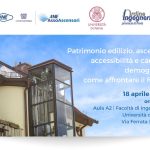Lifting platforms and stairlifts
Today, the ageing of population is constantly growing and the use of products for people with reduced mobility is becoming increasingly important.
Platform lifts and stairlifts are in fact increasingly widespread, not only as a transportation means for people with disabilities, but also for elderly persons with impaired mobility.
STAIRLIFTS
This system has been on the market for long. In England, stairlifts were installed before the Second World War. Currently the production of European manufacturing is a few tens of thousands pieces a year. The main share is represented by stairlifts with chair for private homes and used mainly by elderly people with impaired mobility. The market growth of these systems was strong over the past decade. There are stairlifts with platform, used in private homes and public places (shops, offices, stations etc.), which are used for overcoming architectural barriers by wheelchair (manual or electric) users. The spreading of these systems has remained constant over the last ten years and it has not had strong increments, unlike stairlifts with chair.
Stairlifts are “machines” and fall within the scope of the 2006/42 Machinery Directive provided that their speed does not exceed 0.15 m/s. If they exceed this speed, they are classified in the Lifts Directive. Actually there are no cases of stairlifts exceeding the speed of 0.15 m/s, then we can say that they all fall within the scope of the Machinery Directive.
Stairlifts have had for many years, even before the advent of the European Directives, specific standards issued by various standardisation bodies of the European Member States.
Italy probably has the merit of having launched since 1989 one law on the removal of architectural barriers (Law 13-1989) long before almost all European countries and the Ministerial Decree 236, in 1989, providing technical specifications to be used for the overcoming of architectural barriers and in particular the technical specifications for stairlifts. A short time later, in 1991, the UNI 9801 was issued containing technical specifications for stairlifts.
Other regulatory work at international level was undertaken and completed (ISO 9386-1, dated 2000) in Europe (EN 81-40 dated 2008). In Europe, for stairlift manufacturers there was the need to have a harmonized European standard providing presumption of conformity with the essential safety requirements of Machinery Directive and giving specifications and technical construction techniques, backed up by a risk analysis performed in compliance with essential safety requirements of the Machinery Directive.
The EN 81-40 standard certainly represented a great step forward for the market, allowing to overcome the various national standards which were still observed in several European countries. The regulatory path did not stop and EN 81-40 standard recently underwent a review, still ongoing, aiming at adapting the regulatory requirements to the stairlift state-of-the-art construction technique.
To be fair, it must be said that the harmonized European standards have not to be compulsorily observed, as it is the compliance with the Directive which must be compulsorily ensured. However, they represent a reference of great importance for the manufacturer who has to assess compliance with the Directive: by complying with the harmonized standard, he will have the presumption of conformity with the Machinery Directive.
Let’s summarize the features of a modern stairlift we can say that:
- The reference directives are the 2006/42 Machinery Directive, the Electromagnetic Compatibility Directive (2014/30) and the Low Voltage Directive (2014/35).
- The main safeties to be fitted on stairlifts should be: key switch, emergency stop, safety gear, speed governor, anti-collision sensors and, for stairlifts with platform, access bands to the platform and safety arms for the wheelchair user.
Of course, depending of traction systems, there may be different specific requirements for the traction system used.
LIFTING PLATFORMS
This type of lifting equipment has been on the Italian and European market from the eighties. Especially in Italy, the 236 Ministerial Decree dated 1989 (Regulations for the Implementation of the Law 13 dated 1989 including the technical requirements necessary to guarantee accessibility, adaptability and visibility of private buildings and public housing) states the first technical specifications relevant to lifting platforms. A few lines (still unchanged) referring to the specifications of stairlifts, where applicable.
Lifting platforms have always been affected by their similarity to lifts. In the EN 81-1 and 2 standard dated 1987, it was said that “the application of this standard can be avoided in the case of installation of lifts serving 2 stops, specially manufactured for the transportation of impaired mobility users, with travel not exceeding 4 m and speed not greater than 0.1 m/s where the displacement of the car requires the continuous pressure on a button”. It was a lifting platform considered as a sort of lift.
The spread of the lifting platform has been rapid over the last decade with figures up to 20-25000 units manufactured in Europe. The countries with the largest number of manufacturers are Italy and Sweden.
In the 89/392 Machinery Directive lifting platforms were positioned within the scope of the Machinery Directive itself. The European Commission thus gave a mandate to CEN to prepare harmonized European standards for this product (and for the stairlifts). In 1998, the CEN working group started the drafting of the standards (EN 81-40 for stairlifts and EN 81-41 for lifting platforms).
Let’s make it clear that under the definition of “lifting platform” there are various types of systems:
- Lifting platforms with carrier not fully enclosed, deadman switch without enclosed shaft, usually serving one landing with lifting height up to 3 metres, speeds not exceeding 0.15 m/s;
- Lifting platforms with carrier not fully enclosed, deadman switch with completely enclosed shaft, serving several landings with lifting height up to 13-14 metres, speeds not exceeding 0.15 m/s.
Clearly the lifting height is limited by the very low speed and the deadman switch. These features would make longer travels more difficult to achieve due to the long time (given by the low speed) and the need to press the button for a long time.
These systems can be installed both in private homes and public places and the use is always intended for people with impaired mobility (such as stairlifts for the elderly).
This type of product is well suited for installation in existing buildings (almost all installations) due to its versatility and ability to “fit” very small spaces with a pit of about 140 mm and reduced headroom.
With the introduction of the new Machinery Directive 2006/42, the dividing line between lifts and lifting platforms has become clearer: the lifting equipment for the transportation of persons, persons and goods, goods only, if the carrier is accessible, whose speed is not greater than 0.15 m/s are within the scope of the Machinery Directive.
The new 2006/42 Machinery Directive has introduced another important change: the control devices of ascent and descent must be of the hold-to-run type, except when the carrier is fully enclosed (closed with walls, roof, floor and car door. In this regard, there is still a discussion on the possibility to replace walls and doors with safety barriers).
The EN 81-41 European standard only includes the type “2” platform (see above), always with deadman switch. In order to overcome this situation, the drawing of a standard (named EN 81-42) started, giving specifications for the lifting platforms in an enclosed shaft and non deadman switch controls.
It will soon start also the preparation of standards providing specifications for type “1” lifting platforms, widely used for the overcoming of small rises.
Finally, summarizing the features of a modern lifting platform, we can say that:
- The reference directives shall be the 2006/42 Machinery Directive, the Electromagnetic Compatibility Directive (2014/30) and the Low Voltage Directive (2014/35).
- The main safeties for lifting platforms shall be: key switch, emergency stop, safety gear, speed governor, safety barrier for protecting carrier sides without walls and for platforms with no deadman switch and fully enclosed carrier, automatic landing doors and carrier doors, with anti-crushing door protection with door reopening.
Obviously, in this case, depending on traction systems, there may be different specific requirements for the traction system used.
By Marco Marchetti
EPSA- European Platform & Stairlift Association President










